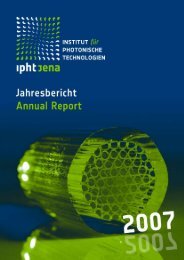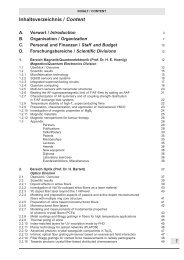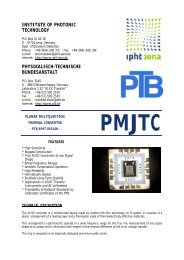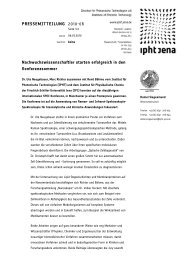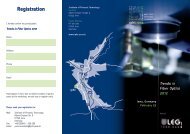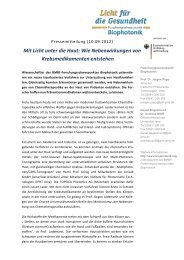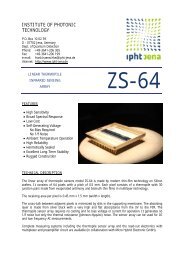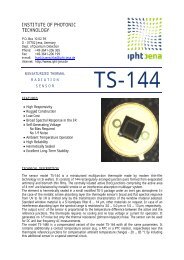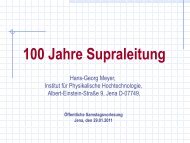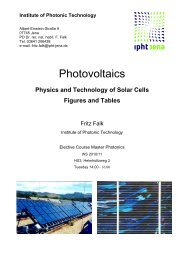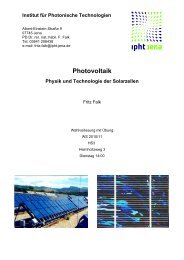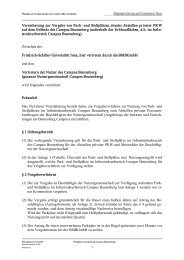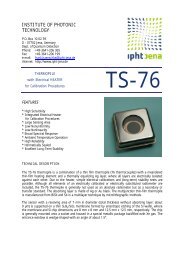Jahresbericht 2005 - IPHT Jena
Jahresbericht 2005 - IPHT Jena
Jahresbericht 2005 - IPHT Jena
You also want an ePaper? Increase the reach of your titles
YUMPU automatically turns print PDFs into web optimized ePapers that Google loves.
70<br />
application of LabOnChip based microfluidic<br />
devices for integrated sample preparation and<br />
placement in micro optical systems. The newly<br />
developed technology for the preparation of allglass<br />
microfluidic devices with coplanar faces are<br />
in compliance with the requirements of microoptical<br />
systems.<br />
A. Microfluidics of liquid-liquid<br />
segmented sample streams<br />
Liquid-liquid segmented flow based on highly<br />
integrated LabOnChip devices offers a powerful<br />
and versatile approach for high-throughput processing<br />
of linearly organized sample streams.<br />
Currently, these fluidic networks are built up from<br />
individual chip modules which are interconnected<br />
by HPLC-capillaries. Since all operations have to<br />
be in plug mode, micro droplets need to be large<br />
enough, to seal a given channel completely. For<br />
widely used HPLC capillaries with an inner diameter<br />
of 0.5 mm this critical volume is about<br />
64 nl. With respect to this, modular systems are<br />
limited in compartment size and thus in throughput<br />
and sample density. Processing of segmented<br />
sample streams uses interface-generated<br />
forces for the maniplation of the micro droplets at<br />
functional nodes with optimized geometry and<br />
wetting conditions. Miniaturization of the channel<br />
system and the droplet volume increases the curvature<br />
of the interfaces and thus the pressure<br />
drop generated at the interface. In conclusion,<br />
not only throughput and sample density, but also<br />
reliability of the processes benefit from miniaturization<br />
and integration. Considering this, our work<br />
in development of LabOnChip devices is focused<br />
on the development of integrated LabOnChip<br />
devices for segmented flow based application.<br />
Toolkit for computational fluidic simulation<br />
and interactive parametrization<br />
of segmented-flow based fluidic networks<br />
(N. Gleichmann, M. Kielpinski, D. Malsch,<br />
T. Henkel)<br />
The main objectives of this work are the application<br />
of principles of electronic design automation<br />
(EDA) to the model based design and parameterization<br />
of segmented-flow based micro fluidic<br />
networks. This approach will significantly increase<br />
the efficiency in development of highly<br />
integrated LabOnChip devices for custom fluidic<br />
and micro chemical protocols. By that way,<br />
research and development of micro chemical and<br />
screening applications will benefit of the promising<br />
micro droplet-based approach of segmented<br />
flow. Our toolkit is based on a computational network<br />
of fluidic nodes, which are interconnected<br />
by virtual fluid ports for the transfer of segment<br />
streams. The particular behaviour of a functional<br />
node may be given by user definable rules, which<br />
MIKROSYSTEME / MICROSYSTEMS<br />
are derived from experimental data and Computational<br />
Fluid Dynamics (CFD) simulations of the<br />
functional element. The geometry is dynamically<br />
generated from photolithographic mask data and<br />
process parameters. Segmented sample streams<br />
are implemented as lists. For interactive inspection<br />
of the interface geometries inside a functional<br />
node a software interface to the surface evolver<br />
is implemented.<br />
Fig. 3.12: Geometry of a drop passing a Tshaped<br />
junction with nozzle.<br />
The surface evolver starts with a dynamically<br />
generated mesh of the node itself and the correct<br />
position of the micro droplets inside the element.<br />
Wetting conditions and local contact angles<br />
are non-constraints and dynamically calculated<br />
from the interface energies. Channel geometry is<br />
generated from the photo lithographical mask<br />
data and the parameters of the etch process. The<br />
parameterization is realized by interactively<br />
changing the mask geometry of the fluidic nodes<br />
and analysing the results of the fluidic simulation.<br />
A complete run for a dynamic simulation takes a<br />
view minutes only. The network can operate with<br />
pressure and volume flow constraints. Currently it<br />
is implemented for non compressible liquid/liquid<br />
two-phase flows and the micro system technology<br />
of isotropic wet etching. The Toolkit consists of<br />
a C++ class library of components for fluidic network<br />
simulation, for user interaction and network<br />
visualization and for interfacing the surface<br />
evolver. In a first test case it was successfully<br />
applied for modelling a double injector module.<br />
Conceptual work on self-controled fluidic<br />
networks for segmented-flow based applications<br />
(M. Kielpinski, D. Malsch, G. Mayer, J. Albert,<br />
T. Henkel)<br />
Functional elements for sample generation, dosing<br />
of liquid into droplets and retrieval of individual<br />
samples from the sample stack, generation of<br />
stacked sequences and controlled fusion of adjacent<br />
segments within it’s segment stream have<br />
been reported and successfully applied for highthroughput<br />
applications. These processes are<br />
mainly effected and controlled by the dynamics of<br />
interface evolution at functional nodes and spe-



